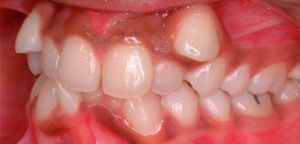 The ideal bite is a rare phenomenon. In the overwhelming majority of people with tight jaw closure, the interaction of the upper and lower dentition to some extent differs from the norm.
The ideal bite is a rare phenomenon. In the overwhelming majority of people with tight jaw closure, the interaction of the upper and lower dentition to some extent differs from the norm.
For example, the front teeth, upper or lower, may be excessively extended forward or there may be no contact between them when the jaws are closed.
Unfortunately, most often this deviation is considered just an unpleasant cosmetic defect, neglecting the fact that an abnormal bite can cause serious problems, and not only dental, but also with the health of the person as a whole.
What exactly are the consequences of an incorrect bite and why is it necessary to fight with such a phenomenon when a problem is detected, both in children and adults?
Contents
- Primary dental problems
- Soft tissue injuries and gum recession
- Temporomandibular joint diseases
- Respiratory problems and ENT diseases
- Digestive disorders
- Difficulties with prosthetics and maintenance of hygiene
- Cosmetic defects and psychological discomfort
- danger for the child?
First and foremost dental problems
The appearance of various complications associated with a malocclusion depends on the type of pathology and the degree of its severity. But, nevertheless, the most common consequence of such anomalies can be with certainty called uneven distribution of the load on the teeth during chewing food.
In this case, some of them almost completely cease to participate in this process, while others have to bear a double burden.
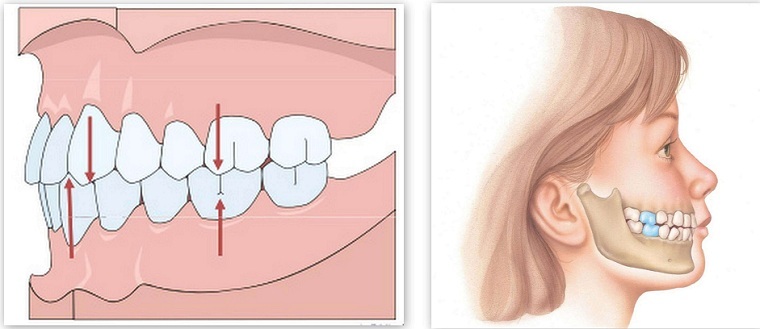
Tooth decay due to improper occlusion is a common matter, so dangerous
It is not difficult to predict the further development of such a situation: on teeth actively participating in chewing, enamel begins to disappear quickly, and the dental tissue itself becomes more fragile, which leads to the appearance of chips and increasesprobability of tooth decay. But even those crowns that are supposed to be at rest, also feel a negative impact: they are more susceptible to the accumulation of bacteria and plaque, which can eventually provoke the development of caries.
In parallel with this, there is a decrease in chewing activity in general, as only a part of the teeth takes part in the process of ingestion. If a person, trying to crush products qualitatively, begins to tighten the crowns more tightly, there can be not only discomfort, but also painful sensations. Also, there are often difficulties with swallowing food, which in turn further contributes to the development of carious processes.
In addition, an uneven load on the teeth with an incorrect bite with time can lead to their premature loss. This is due to the constant loosening of the crowns, providing chewing food, because of what the periodontal pocket gradually increases, turning into a place of accumulation of pathogenic bacteria.
The resulting inflammation, often affecting the root of the tooth, without timely treatment can lead to even its loss.
Soft tissue injury and gum recession
Bite abnormalities suggest an incorrect position of the teeth that can be inclined inside the oral cavity or, conversely, in the 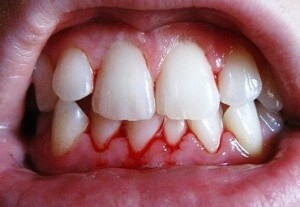 side of the lips.
side of the lips.
Therefore, eating or even ordinary conversation is often fraught with unpleasant consequences - injuries to the inside of the cheeks and side surfaces of the tongue. An additional danger is represented by protruding sharp edges, formed on the teeth due to chips.
In this case, the periodically appearing injuries of this kind cause a person not only discomfort, but also carry a rather serious health threat in the form of non-healing ulcers, foci of inflammation, edema and stomatitis.
In addition, the uneven distribution of the chewing load imposes a negative imprint not only on the crowns themselves, but also on the condition of the soft tissues surrounding them.
The volume of gum tissues gradually decreases, they wear out quickly, revealing the roots of the teeth. Bacterial plaque accumulates in the formed depressions, creating ideal conditions for caries.
In parallel, periodontitis can develop, a disease characterized by an inflammatory process in the gums, which is accompanied by bleeding, pain and bad breath.
Diseases of the temporomandibular joint
Diseases of the TMJ are one of the most severe consequences of a malocclusion, and they are very poorly treatable.
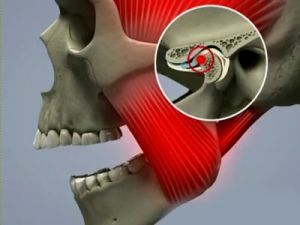 In the overwhelming majority of cases, the reason for this is the improper arrangement of the incisors, which eventually leads to displacement of the jaw joints relative to each other.
In the overwhelming majority of cases, the reason for this is the improper arrangement of the incisors, which eventually leads to displacement of the jaw joints relative to each other.
This phenomenon is often accompanied by unpleasant symptoms in the form of headaches and ear pains, dizziness, muscle spasms, as well as crunching and snapping while eating or talking. In parallel, it may develop bruxism, that is, grinding teeth during sleep.
A similar phenomenon is associated with excessive loads on the muscular jaw apparatus, from which a person in a dream tries to unconsciously get rid of by gritting his teeth.
Breathing problems and ENT diseases
In severe anomalies, an incorrect bite can eventually provoke a serious impairment in the person in the form of a partial or complete replacement of nasal breathing with the mouth.
In the future, such a problem, complicated by the accumulation of bacteria in the oral cavity, can make a person predisposed to various kinds of ENT diseases, for example, sinusitis, sinusitis, otitis, tonsillitis, etc., which will be very difficult to manage without consulting an orthodontist dentist.
Dysfunction in the digestive tract
Problems in the functioning of the digestive system often appear in people with abnormal arrangement of the crowns due to their inability to chew food properly.
Digestion of poorly shredded products requires a strong regimen of the gastrointestinal tract, provoking gastritis, enterocolitis and problems with stool, the treatment of which will be very difficult without eliminating the root cause of their appearance.
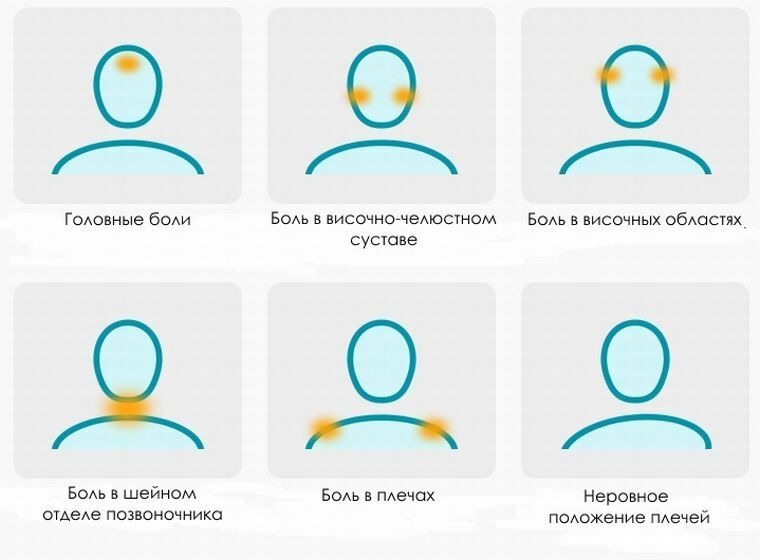
Difficulties with Prosthetics and Hygiene Maintenance
People with dental disabilities often have difficulty in maintaining oral hygiene.
Because of the unnatural arrangement of the teeth, it is difficult to clean them qualitatively from food debris and bacterial plaque, which in turn provokes the development of caries and other similar diseases. 
In addition, difficulties may arise with some dental procedures, in particular, prosthetics and restoration of teeth.
But in fact, in the case of an abnormal bite in such procedures, there is often a need, since the crowns to which the main load falls, have to be replaced with artificial teeth.
Contraindicated for people with a similar problem and some other dental aesthetic procedures, for example, the installation of veneers.
Cosmetic defects and psychological discomfort
This is primarily about the unattractive appearance of the smile itself in case of abnormal occlusion, as well as changes in the proportions of the face, for example, an excessively prominent lower jaw, visually enlarging the chin, or constantly open the mouth.
At the same time, even seemingly insignificant deviations from the norm can affect the life of a person, because in some cases of incorrect bite it is forbidden to engage in certain kinds of sports, for example, diving. And more serious anomalies often cause isolation, low self-esteem and even depression.
Often in a similar situation suffers and diction due to the fact that the normal operation of the speech device is significantly complicated because of the unnatural position of the teeth.
What is the danger for the child?
Some parents mistakenly believe that in an abnormal bite of a child there is no threat to his health, because the baby's teeth will soon be replaced, and with them all problems will disappear.
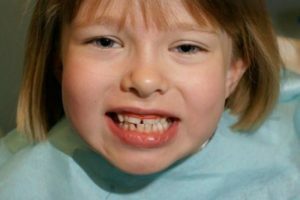 But, unfortunately, this statement is far from the truth. In practice, the consequences of malocclusion in children can be no less serious than in adulthood: a change in facial features, frequent headaches, problems with digestion of food, as well as spoilage and early tooth loss.
But, unfortunately, this statement is far from the truth. In practice, the consequences of malocclusion in children can be no less serious than in adulthood: a change in facial features, frequent headaches, problems with digestion of food, as well as spoilage and early tooth loss.
In addition, if abnormalities in the occlusion in a child are provoked by incorrect development of the upper or lower jaw, eruption of permanent teeth will also be accompanied by problems that must be eliminated by contacting a specialist no later than 5 years of age.
Thus, it is obvious that the issue of bite anomalies in children and adults should in no case be ignored, neglecting its possible consequences.
And the sooner it will be possible to recognize the problem and seek qualified help, the higher the probability that the situation can be corrected, thus avoiding more serious health problems.
